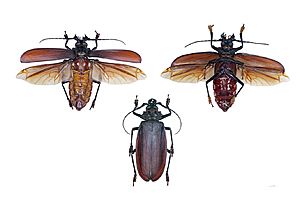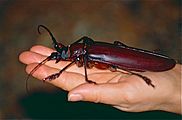Titan beetle facts for kids
Quick facts for kids Titan beetle |
|
|---|---|
 |
|
| Titanus giganteus | |
| Scientific classification | |
| Synonyms | |
|
(Genus)
(Species)
|
The titan beetle (Titanus giganteus) is a super-sized longhorn beetle. It lives in the rainforests of South America. It is the only species in its group, Titanus, and is known as one of the biggest beetles on Earth!
What Makes It Special?
The titan beetle is one of the largest beetles in the world. Some have been measured at over 16.7 centimeters (about 6.6 inches) long! This makes it similar in size to other huge beetles like the Xixuthrus heros and the Hercules beetle.
Even though the Hercules beetle can be longer, much of its length comes from a huge horn. The titan beetle's body is actually much bigger and heavier. It has short, curved, and very strong jaws called mandibles. These jaws are powerful enough to snap a pencil in half.
Adult titan beetles do not eat. Instead, they fly around looking for mates. They use special scents called pheromones to find each other.
Life Cycle of the Titan Beetle
Scientists have never found a titan beetle larva (the young, worm-like stage). However, they believe the larvae live inside wood. They likely eat decaying wood found underground. It might take several years for a larva to grow to its full size.
Some holes found in wood are thought to be made by these larvae. These holes suggest the grubs could be over two inches wide and up to a foot long! A famous photo in National Geographic magazine once showed a huge larva. But it turned out to be a different type of beetle, not the titan beetle.
Adult titan beetles have ways to protect themselves. They can make a loud hissing sound to warn others. They also have sharp spines and those strong jaws for biting.
Where Does It Live?
The titan beetle lives in the warm, wet rainforests of South America. You can find it in countries like Venezuela, Colombia, Ecuador, and Peru. It also lives in the Guianas and parts of north-central Brazil.
Gallery
-
Titanus giganteus at the Montréal Insectarium
See also
 In Spanish: Escarabajo titán para niños
In Spanish: Escarabajo titán para niños





